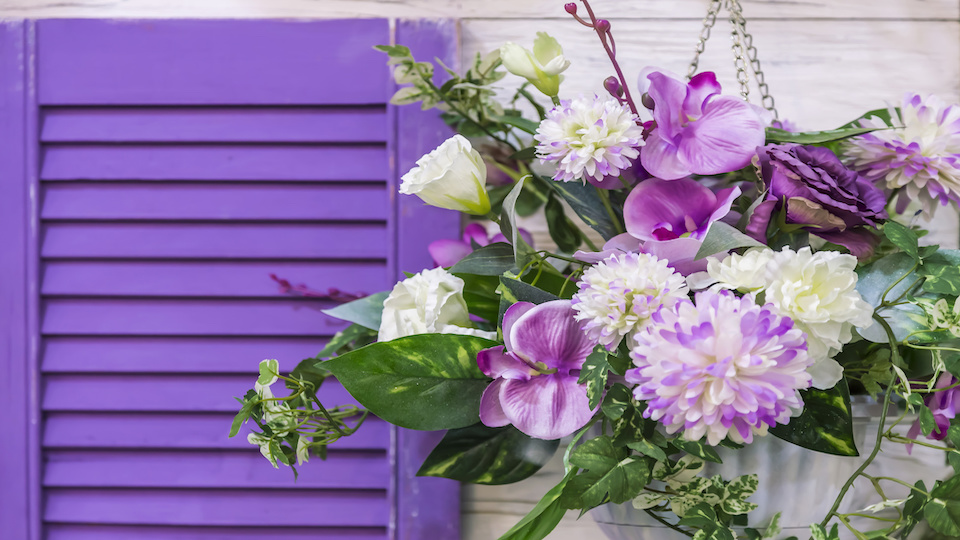Do you love to be surrounded by vibrant plants but are short on space? You can fit a vertical garden anywhere, indoors or outdoors, and have plenty of gardening fun. A vertical arrangement will help you fit more plants in a small area. Try these ideas for fun ways to try your hand at vertical gardening.
Plant organizer
Pots-on-a-frame is the most common type of vertical garden. It is composed of a wire frame on which specially made plastic pots are hung in rows. A lightweight potting mix is used to plant the pots with a mix of bromeliads, ferns, short grasses or succulents. Some of them have an inbuilt watering system, too.
You can make a simpler system with an over the door shoe organizer.
Fix the organizer onto a wall or a frame and fill the pockets with cocopeat and compost mix. Plant larger plants in the bottom rows and smaller ones toward the top. If you attach a felt backing, it will wick water to all the pouches and keep the plants sufficiently hydrated.
Cinder-block Steps and stairs
One of the easiest vertical garden arrangements, this container has all the plants growing in individual pots that are closely arranged on the steps of the stairs to get a massed effect. The main advantage of this is that every plant gets sufficient light and no plant is entirely in the shadow of the one above it.
In case you can’t find any wooden stairs or old step ladders to repurpose, make your own stairs against a wall with cinder blocks. The holes should be facing up so that you can grow your plants in them. If you’re building the stairs on the patio or another porus surface, don’t forget to add in a waterproof lining to prevent water damage.
Step-by-step tower garden
Freestanding plastic planting towers with several tiers of pockets are now available. All you have to do is fill the main cylinder with potting mix and plant in the little pockets. An even better option would be making your own tower garden by stacking smaller planters over larger ones. Use rectangular or circular planters, and fill each one with potting soil, packing it in the central area to take the weight of the next one. The larger plants at the bottom would appreciate some extra space to spread out their roots.
Hanging garden
Vertical gardens don’t always have to be built from the floor upwards. You can have a hanging arrangement that frees up floor space. Find a sturdy tree branch in the yard to hang a piece of welded wire fencing with PVC coating. Pass several loops of rope over the branch and attach hooks to them. Make sure that you protect the branch with sufficient padding so that the cords don’t cut into the bark. Hang up the wire fencing grid and arrange vertical garden pots planted with shade-loving plants. You can even have a drip watering system with a hose pipe going up the tree and over the hanging arrangement. Indoors, the piece of wire fencing for the hanging garden can be suspended from brackets fixed to the wall or hooked to a load-bearing beam in the ceiling.
Succulent wall hanging
This is a very easy and quick vertical garden to brighten up any drab wall. You need a wooden box/packing crate of 2-3 inch depth. After attaching two keyhole brackets to the back of the box, fill it with well-draining potting mix. Cover the box with a piece of mesh shade net or burlap and staple it to the sides of the box. Fix a plastic coated square grid wire mesh over this. Insert succulent plugs or cuttings into each square by making a small slit in the net layer. When the plants get established, hang up your picture-perfect garden piece.
The original vertical garden
The vertical garden trend may seem like a recent thing in response to space scarcity in the cities, but such gardens have always been around. It is just that, instead of an arrangement of pots, they were using naturally climbing and trailing plants planted on the ground and trained on walls, trellis or other supports. The main advantage of this type of vertical garden is that watering can be limited to the root zone which remains in the ground or at the bottom.
Different types of ivies, sweet potato vines, and flowering climbers can be trained on chain-link fences to create extensive vertical gardens without much expense. Philodendrons and pothos can be used to create easy-to-care-for vertical gardens on fences or trellises.
Pothos room divider
Attach a garden fence section or trellis to one side of a narrow rectangular wooden box 2-4 feet long. Place pots of different varieties of pothos, such as neon, jade, marble queen, zebu blue, etc., inside the box. Attach their trailing stems to the trellis with small butterfly clips or zip ties. Their colorful foliage will soon fill the trellis to form a pretty room divider or privacy screen. Trailing philodendrons, syngoniums, ivies or even flowering climbers may be used instead, or along with pothos, to create various patterns.
-Susan Patterson




